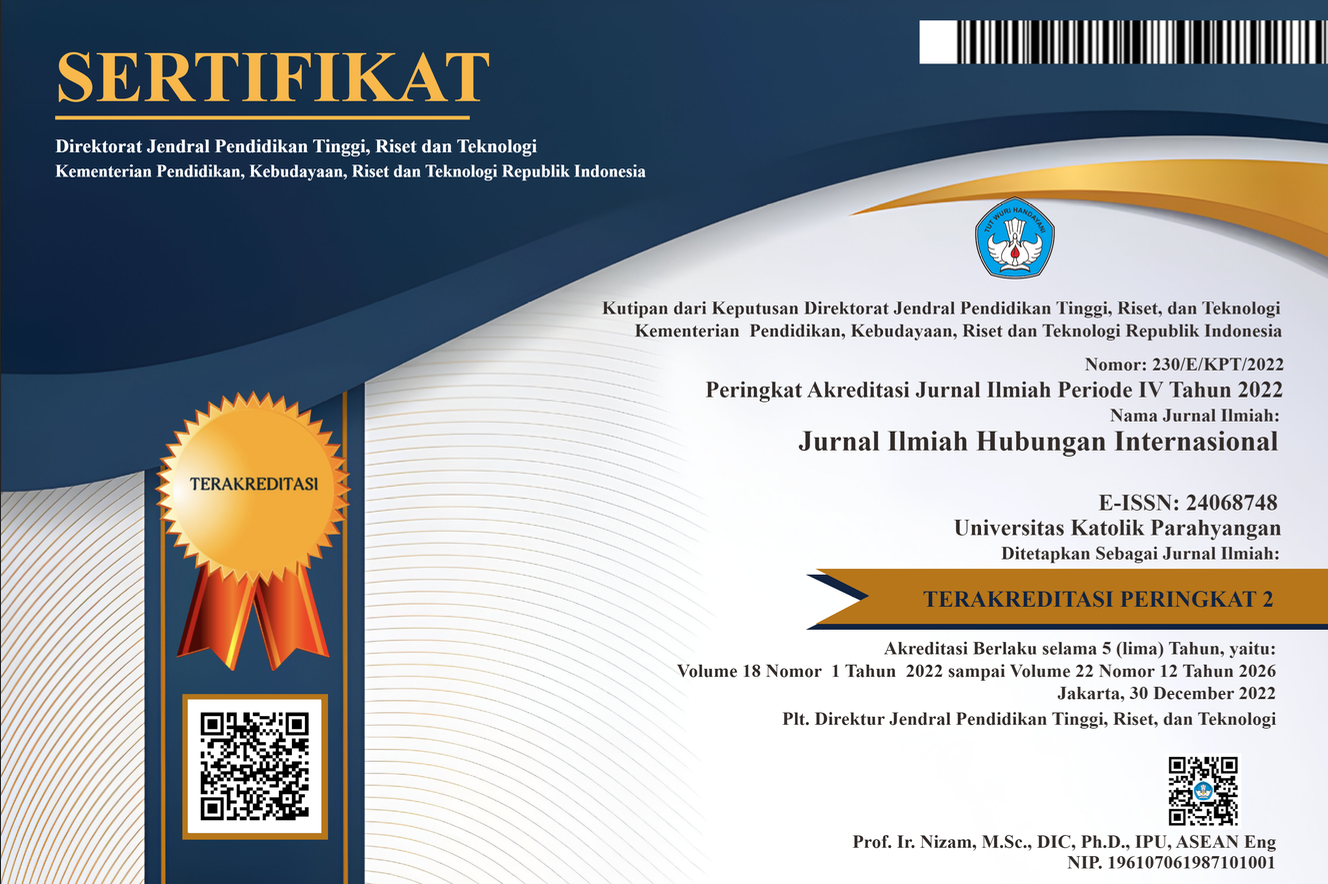Diplomasi Ekonomi dan Militer India di Asia Tenggara sebagai Pendukung Keberadaan Kluster Industri Militer
Abstract
Tulisan ini mengeksplorasi Asia Tenggara sebagai pasar yang potensial untuk Kluster Industri Militer. Tiga Negara yang merepresentasikan area ini adalah Myanmar, Thailand, dan Singapura. Setiap Negara memiliki spesifikasi yang unik, termasuk keuntungan absolut yaitu Negara India sebagai Negara tetangga. Myanmar memiliki potensi geopolitik dan sumber daya alam mentah yang berlimpah, sedangkan Singapura memiliki keuntungan kompetitif yaitu dapat mengelola sektor jasa. Dibandingkan dengan dua Negara sebelumnya, Thailand hanya memiliki keuntungan dari diaspora India sebagai komponen pendukung dari keberlanjutan dari Kluster Industri Militer. Tapi, kuantitas ini memberikan jaminan bahwa India tidak pernah mengabaikan posisi Negara di setiap kebijakannya. Selain itu, penulis menyimpulkan jika ekonomi dan diplomasi militer harus diambil oleh Least Developed Country, khususnya sebagai ekonomi, yang menempatkan industry militer sebagai prioritas pengembangan sub-sektor. Argumentasi yang paling mendesak adalah model monopsoni yang memiliki latar belakang kostumer yang minimum, sedangkan ketersediaan volume permintaan absolut untuk kinerja kluster.
References
Buku
Bitzinger, Richard A. 2009. The Modern Defense Industry :
Political, Economy, Technological Issues. California : ABC-CLIO
Hoyt, Timothy d. 2006, Military industry and regional defense policy: India, Iraq, and Israel, London: Routledge.
Nye, Joseph Samuel. Jr. 2004. Soft Power : the Means to Success in World Politics. New York : Public Affairs
_________________2010.Cyber Power. Belfer Center for Science & International Affairs .May.
_______________________ , 2011. The Future of Power. New York. Public Affairs
Rana, Kishan S & Bipul Chatterjee. 2011. Economic Diplomacy : India’s Experience. Rajasthan : CUTS International
Wang, Rong and Cuiping Zhu (ed). 2015. Annual Report on the Development of International Relations in the Indian Ocean Region (2014). New York : Springer.
Kamphausen,Roy. Et all. 2010. The PLA at Home and Abroad : Assessing the Operational Capabilities of China’s Military. Forbes Ave, Carlisle : All Strategic Studies Institute
Jurnal
Neuman, Stephanie G. 1994. “Arm Transfers, Military Assistance, and Defense Industries : Socio economic Burden or Opportunity ?”.
Annal of the American Academy of Political and Social Science Vol 535 : The Arm Trade : Problem and Prospect in the Post Cold War World (Sept)
Ross, Andrew L. Peter Dombrowski. 2008.”The Revolution in Military Affairs, Transformation and the Defence Industry”. Security Challenges, Vol. 4, No. 4 (Summer )
Barman, Arup. 2001. India – Thailand’s Engagement in HRD Diplomacy A Case. SSRN Electronic Journal (July)
Muthanna, KA. 2011. “Perspektif of Military Diplomacy”. Journal of Defense Studies Vol V No 1 (January)
Artikel
Biegon, Rubrick. 2013. “The Banality of Smart Power : Reconstituting US Hegemony after Bush”.International Paper that was submitted for University of Kent POLIR Post Grad Conference 17 May.
Internet
Dowdy, John et all.2014. “Southeat Asia : the next growth opportunity in Defense”.www.mckinsey.com/.../aerospace%20and%20defense/.../sea%20defense
“Indo –US Defense Technology Cooperation” by Sudesh Rani 28 Feb 2013 in http://maritimeindia.org/article/indo-us-defence-technology-cooperation
Kronstadt, K Alan, et al 2005. “US –India Bilateral Agreement in “http://www.au.af.mil/au/awc/awcgate/crs/rl33072.pdf
Mukhim, Patricia.2013.”India –Myanmar Economic Partnership and the Development of India’s North
East.”.http://ris.org.in/images/RIS_images/pdf/India-Myanmar%20Meeting%204%20feb%202013%20PPT/Patricia.pdf
Research Unit for Political Economy. 2006. “Why the United States Promotes India’s Great – Power Ambitions”. Monthly Review, Vol 57, Issue 10 (March) on
http://monthlyreview.org/2006/03/01/why-the-united-states-promotes-indias-great-power-ambitions/
“U.S., India Agree to Collaborate on Advanced Defense Technologies” Sept 30 2013. In http://www.nti.org/gsn/article/us-india-agree-collaborate-new-defense-technologies/
“U.S. & India Sign 10-Year Defense Pact” Jun 30, 2005 in http://www.defenseindustrydaily.com/us-india-sign-10year-defense-pact-0783/
Wadhwani Chair in U.S.-India Policy Studies in http://csis.org/program/us-india-security-and-defense-cooperation
Downloads
Published
How to Cite
Issue
Section
License
This journal uses Creative Commons license (CC BY). We allow readers to read, download, copy, distribute, print, search, or link to the full texts of its articles and allow readers to use them for any other lawful purpose. The author must be aware that the article copyrights will be fully transferred to Jurnal Ilmiah Hubungan Internasional only if the article is accepted to be published in the journal through signing of the Copyrights Transfer Agreement. Authors are allowed to resend their manuscript to another journal or intentionally withdraw the manuscript only if both parties (JIHI and Authors) have agreed on the related issue. Once the manuscript has been published, authors are allowed to use their published article under Jurnal Ilmiah Hubungan Internasional copyrights.








